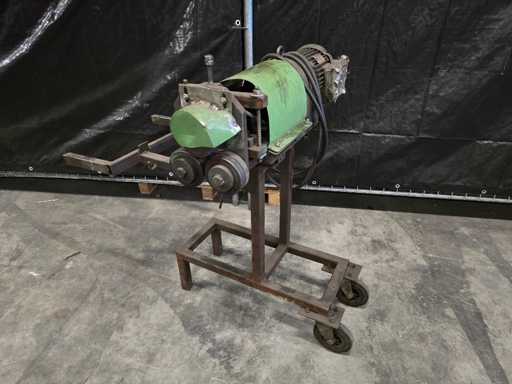Ring & Profile Bending Machines
Profile & ring bending machines in proven quality
What is a profile-bending machine?
Before defining a profile-bending machine, it is important to specify what “a profile” refers to. Profiles are rod shaped products, used to retain a cross-section across their entire length. There are several types of profiles, such as tubes, window frames, bars, I-beams, T-beams and structural profiles. During the process of their manufacture, particular care is taken to ensure linearity. Prior to their application, profiles need to be adjusted to fit the specific requirements. This is the task for a profile-bending machine. The standard design of a profile bender is usually the same, regardless of manufacturer. Profile-bending machines usually consist of three rollers that are, in industrial settings, hydraulically operated. In addition to the hydraulic profile-bending machine, there are also the manually operated ones that function using jack screws.
Profiles are rod shaped products
Used to retain a cross-section across their entire length
They need to be adjusted to fit the specific requirements
Quality Great offers Personalized
The difference between a manual and a hydraulic profile-bending machine
Manually operated profile-bending machines are primarily used for skilled crafts and trades. For instance, automobile workshops use them to manufacture certain parts such as exhausts and give the pipes specific characteristics of their own workshop. The construction of such profile-bending machines is usually the same: two rollers lie in a row, while the third roller is staggered across them. The workpiece is then placed between the two linear rollers and the staggered roller. The rollers are put into motion using a button, after which they start moving on top of one another.
INDUMASCH Profile-bending machine in use
A highly powered hydraulic profile-bending machine is required for precise results. The bending process on these metalworking machines begins as soon as the rollers and the workpiece meet and it can be stopped either automatically or manually. At the end of the process, the rollers move away from each other and the profile has its new desired form. As an alternative to the three-roller design, there are also profile-bending machines that use a special custom-made tool as the forming element. The profile is then pressed into place using this machine. This process is commonly used in mass production.
The use and operation of profile-bending machines
There is a wide range of profile-bending machines available and they are primarily used to carry out cold bending on profiles which differ in shape and size. Different profile-bending machines can be used to process profiles ranging from profile cross sections of a few millimetres in diameter up to pipelines with a cross-section of over two metres. Bending of profiles has to be conducted with a lot of direct power, but also allow for controlled straightening, which is achieved through the use of a profile-bending machine. If a profile was simply fixed onto the machine and bent, it could never form the desired shape and would eventually just snap. This is especially true for hollow profiles like tubes or frames of heat-insulating windows. However, with a profile-bending machine, profiles are bent into the right shape with utmost caution and precision, and without inflicting any damage on them.
Working with a profile-bending machine requires a lot of experience unless it is for the mass-production of small pieces, which is largely automated. A certified qualification is not necessary, but unskilled workers must have intensive and supervised training in order to use a profile bender properly. This is particularly important for complex forms or high-end products like tubes for pipelines.
Well-known manufacturers
In the industrial context, well-known manufacturers are KNUTH, ROUNDO, VOORTMANN and THOMAN. A good used profile-bending machine for workshops and construction sites is available from O+P, GRANGIER CONSTRUCTEUR, and NUOVA. Suppliers of machines for particularly large products are SUPERIOR and GENERAL DISCILLING.
Quality used machines by many of these brands can often be found in good condition on our website, as well as in our industrial auctions, at a competitive price.


